Constructivism learning theory transforms traditional education, emphasizing active student participation and knowledge construction. It’s an approach that’s reshaping how educators teach and students learn.
- Discover what constructivism learning theory is and its pivotal role in education.
- Explore key principles and examples of constructivism in action.
- Understand the impact of social constructivism on collaborative learning environments.
Curious about revolutionizing your teaching methods? Keep reading to grasp the full potential of constructivism learning theory and how it can revitalize your classroom dynamics.
What We Will Explore
Constructivism Learning Theory: A Detailed Explanation
Constructivism learning theory represents a significant shift in educational philosophy, fundamentally changing our approach to teaching and learning. This theory, central to modern pedagogical methods, challenges traditional views of knowledge transmission and places the learner at the forefront of their educational journey.
What is Constructivism Learning Theory?
At its essence, constructivism posits that learners actively construct their own understanding and knowledge of the world, not through passive absorption but through engaging with and reflecting on their experiences. This approach marks a departure from rote memorization, instead fostering critical thinking and problem-solving skills.
By embracing this approach, educators can create more dynamic, interactive, and personalized learning experiences. Constructivism learning theory examples in the classroom might include project-based learning, where students tackle complex, real-world problems, or collaborative discussions that allow learners to share and develop ideas collectively.
Key Principles of Constructivism
These principles are not stand-alone pillars; they interweave to create a robust framework for constructivism learning theory in practice.
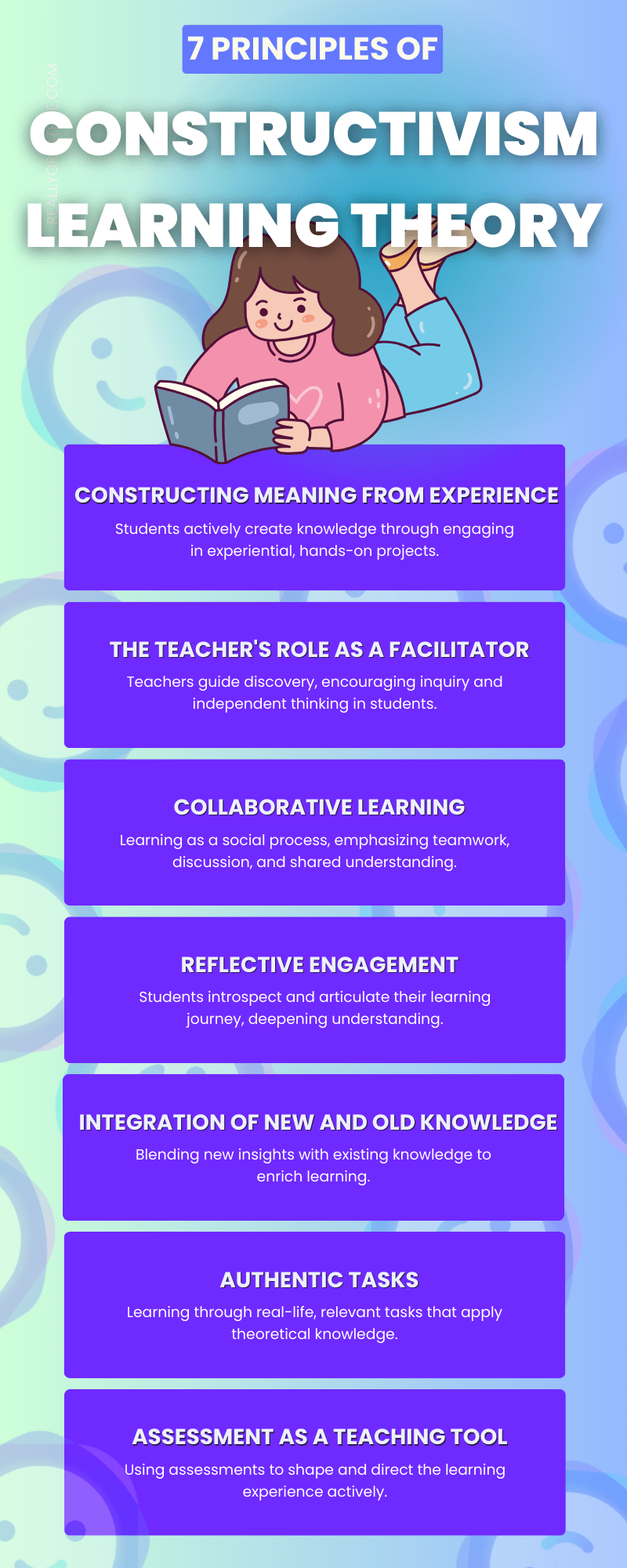
Constructing Meaning from Experience
- What it is: Learning is seen as a process of personal discovery.
- In the Classroom: Students might work on a science project, forming hypotheses based on their observations and testing them through experiments.
Collaborative Learning
- What it is: Learning is a social activity, and understanding is reached through dialogue and cooperation.
- In the Classroom: Group projects where students must negotiate, explain, and compromise are common, illustrating social constructivism learning theory.
Reflective Engagement
- What it is: Learners are encouraged to reflect on their experiences and learning processes.
- In the Classroom: Journals or blogs where students articulate and reflect upon their learning experiences and the outcomes.
Integration of New and Old Knowledge
- What it is: Learners are encouraged to integrate new information with existing cognitive constructs.
- In the Classroom: Students compare and contrast historical events with current ones, finding patterns and making connections.
Authentic Tasks
- What it is: Learning involves real-world tasks that are relevant to the learner.
- In the Classroom: Students might engage in a simulation that mirrors a complex societal issue, requiring them to apply learned concepts in a practical manner.
Assessment as a Teaching Tool
- What it is: Assessment is used to support and guide the next steps in learning rather than just to measure knowledge.
- In the Classroom: Run assessments or quizzes using tools like ClassPoint’s interactive quizzes, which allow real-time feedback and for teachers to assess student understanding and immediately adjust instruction accordingly.
Here are 50 use cases of interactive quizzes and assessments you can conduct in your classroom.
Constructivism Learning Theory in the Classroom
When constructivism learning theory is applied in the classroom, it transforms the traditional teaching landscape into a dynamic canvas where students paint their own understanding through a palette of experiences. The classroom becomes a living laboratory where learning is not just taught but caught, experimented with, and understood on a profound level.
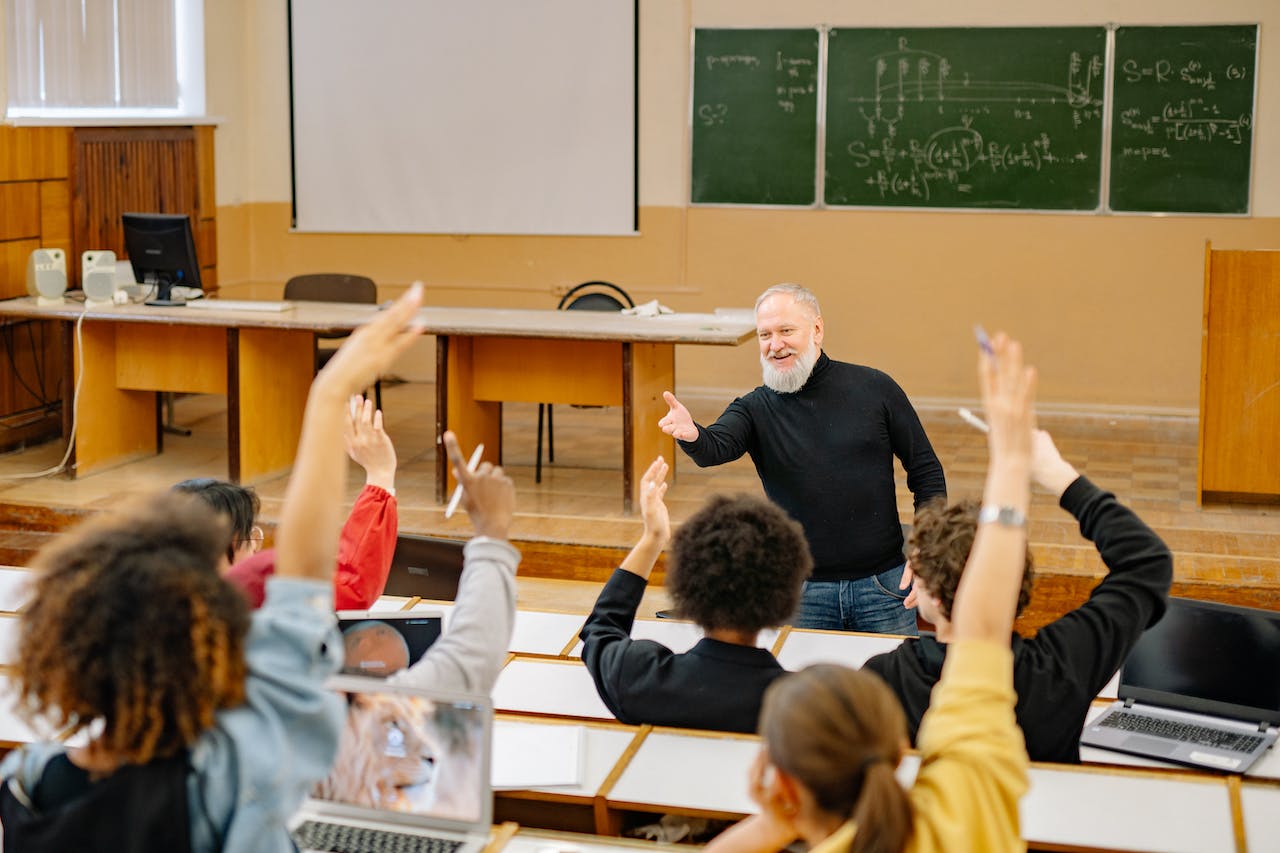
A Day in a Constructivist Classroom
Imagine stepping into a classroom where the constructivism learning theory is in full swing. Here’s what you might witness:
- Interactive Learning Stations: Each corner of the room is a gateway to a different concept, inviting students to interact with the material in a hands-on manner. Here, the principle of “learning by doing” is not just a catchphrase but a reality.
- Dialogue and Debate: The hum of lively discussions fills the air, punctuated by the excitement of discovery. This social constructivism learning theory in action fosters a rich exchange of ideas and perspectives, deepening understanding and respect among students.
- Student-Led Demonstrations: Instead of a teacher at the front, students take turns leading activities or explaining concepts, embodying the adage “to teach is to learn twice.” These peer-to-peer exchanges cement knowledge and build communication skills.
- Project-Based Assignments: Groups are huddled together, brainstorming for their latest project that tackles a real-world issue. This approach not only makes learning relevant but also develops critical thinking and collaborative skills.
- Project-Based Learning (PBL): A hallmark of constructivism learning theory examples in education, PBL immerses students in real-world challenges. Here, students take on projects that require them to apply what they’ve learned in class to solve practical problems. Whether it’s designing a community garden to understand environmental science or creating a business plan in an economics class, PBL makes learning tangible and relevant.
- Case Studies and Simulations: In subjects like social studies or science, case studies of historical events or scientific phenomena allow students to explore scenarios in depth. Simulations, on the other hand, provide an interactive way to understand complex systems, such as a mock United Nations summit to learn about global diplomacy.
- Inquiry-Based Science Education (IBSE): Emphasizing the ‘how’ and ‘why’ over the ‘what’, IBSE encourages students to conduct experiments, make observations, and draw conclusions, mirroring the real processes of scientific discovery and reinforcing the constructivist approach of learning through experience.
- Flipped Classrooms: This approach, aligning with constructivism, reverses the traditional learning model. Students first explore new concepts at home, often through interactive, technology-based media, and then apply this knowledge in class through discussions, problem-solving tasks, and collaborative activities.
Constructivism Learning Theory Strategies Teachers Should be Aware of
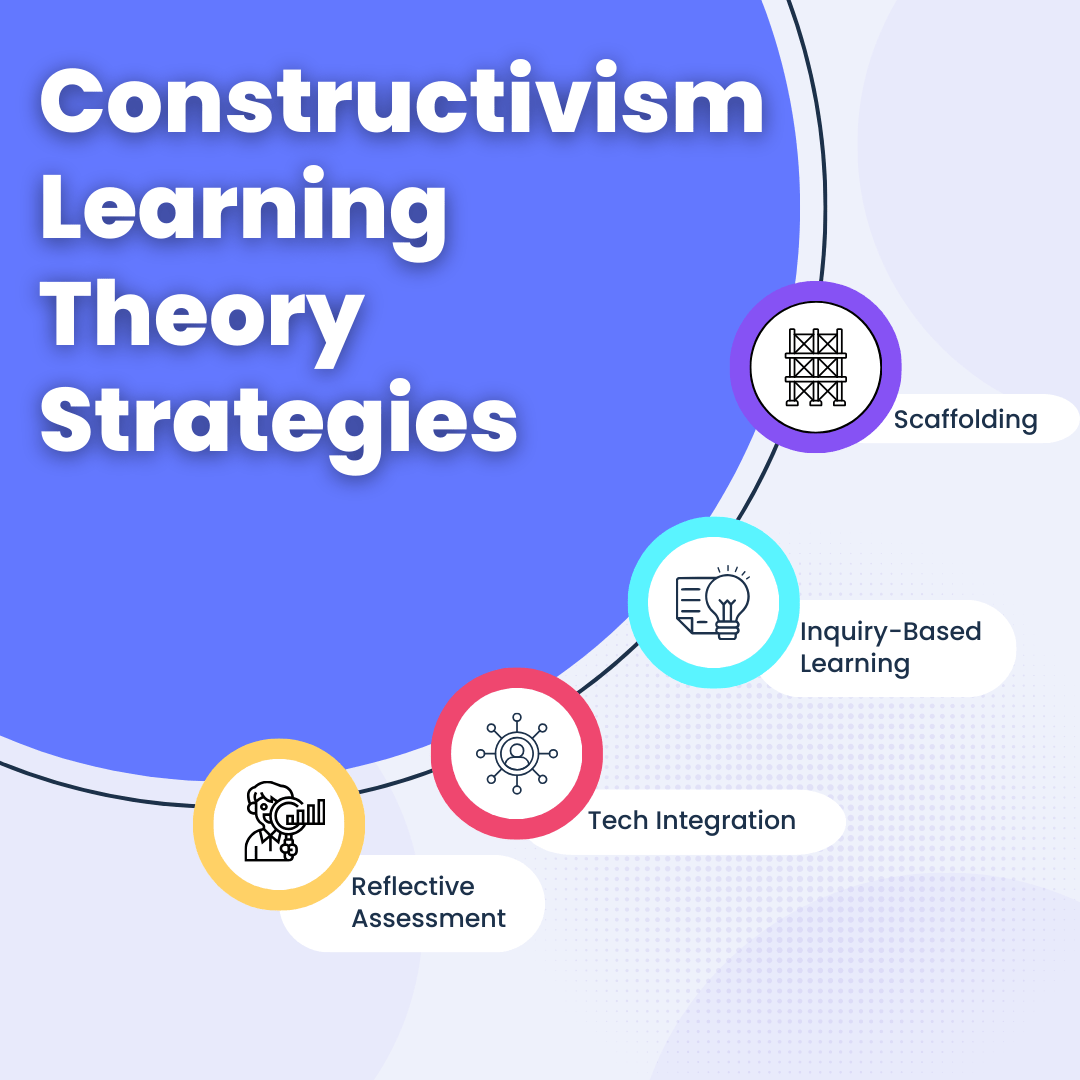
Let’s break down some of the strategies that exemplify constructivism learning theory in the classroom:
- Scaffolding: Teachers provide temporary support structures for students to climb to higher levels of thinking. As students progress, these supports are gradually removed, promoting independence.
- Inquiry-Based Learning: Questions are the currency of the realm, with students encouraged to ask and explore their own questions about the subject matter, leading to a deeper understanding.
- Integration of Technology: Tools like ClassPoint are woven into the fabric of classroom activities, making learning interactive and tech-savvy. Quizzes and polls become not just tools of assessment but of engagement.
- Reflective Assessment: Students regularly stop to reflect on what they have learned, how they have learned it, and what it means for them. This reflective practice solidifies learning and encourages self-assessment.
- Teacher as a Guide: The teacher is no longer the sole source of knowledge but a guide who sets up the environment and provides the resources for discovery.
- Responsive Teaching: Teachers listen to students’ ideas and questions, responding with prompts, hints, and new challenges to push their thinking further.
Constructivism Learning Theory Beyond the Classroom
Constructivism learning theory also extends its influence beyond traditional educational environments:
- Workplace Training: Modern corporate training often employs constructivist approaches, such as hands-on training, simulations, and collaborative projects, recognizing that adults learn best through experience and application.
- Community Education and Workshops: Community programs often use constructivist methods, like group discussions and active problem-solving, to engage participants and address local issues effectively.
Social Constructivism Learning Theory: A Variant
What is Social Constructivism Learning Theory?
Social constructivism learning theory, a vibrant strand within the broader constructivism learning theory, places significant emphasis on the power of social interactions and cultural contexts in shaping the learning process. This perspective not only enriches our understanding of how knowledge is constructed but also highlights the importance of collaboration in the classroom.
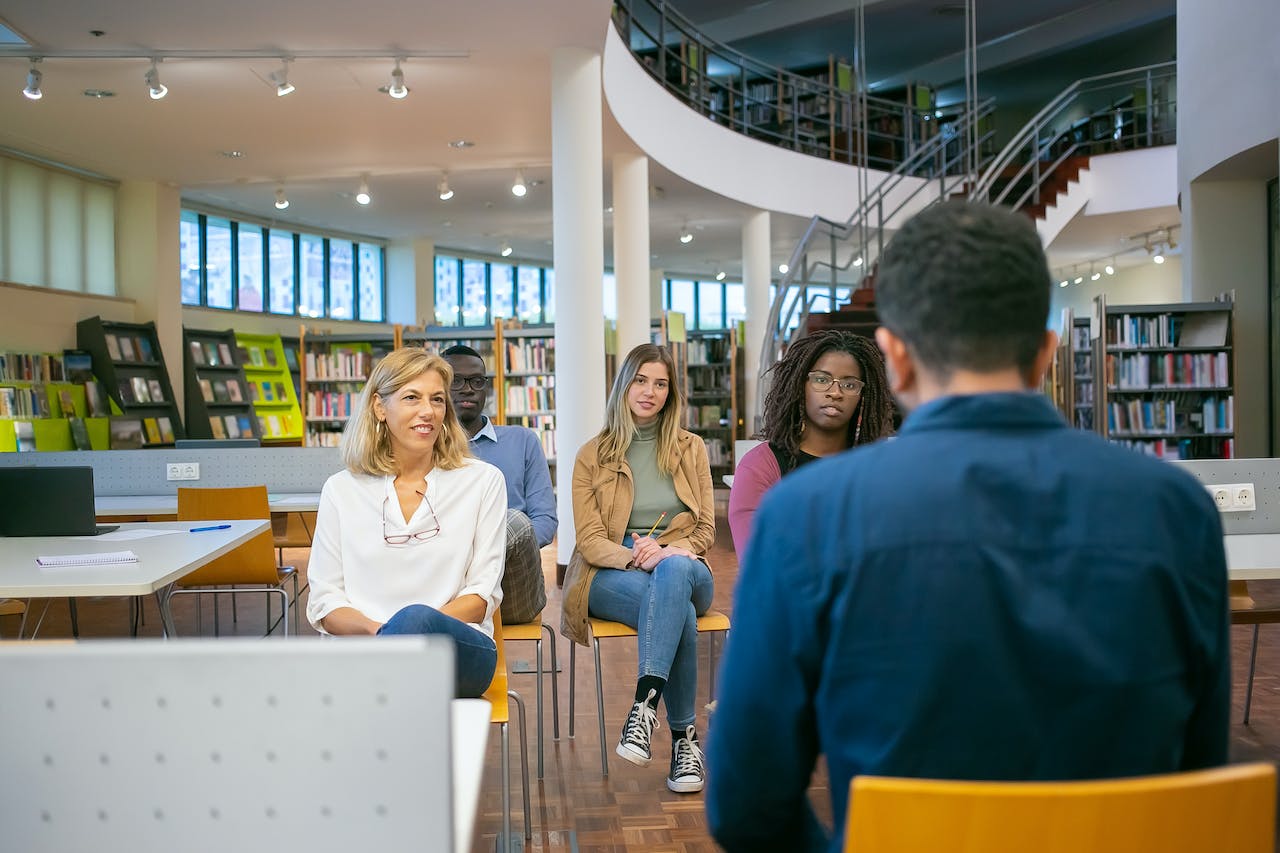
The Essence of Social Constructivism
At its core, social constructivism learning theory revolves around the idea that social encounters are fundamental to the development of cognition. This theory underscores the following aspects:
- Collaborative Learning: Learning is not an isolated activity. It flourishes through shared experiences and interactions with peers and teachers. Social constructivism suggests that understanding is deepened and diversified when learners engage in discussions, group projects, and collaborative problem-solving.
- Cultural and Social Contexts: Every student brings a unique set of cultural and social experiences to the classroom. Social constructivism recognizes that these backgrounds significantly influence how individuals perceive and understand the world, advocating for a learning environment that values and integrates these diverse perspectives.
- Language as a Learning Tool: Communication plays a pivotal role in social constructivism. Through dialogue, debate, and discussion, students articulate their understanding, challenge each other’s viewpoints, and build a shared comprehension of subjects.
Implementing Social Constructivism in the Classroom
To embrace social constructivism learning theory, educators can adopt various strategies:
- Group Work and Peer Learning: Encourage students to work together on projects or study groups, facilitating the exchange of ideas and peer teaching.
- Class Discussions: Regularly engage the class in discussions where diverse viewpoints are welcomed and explored. This not only aids in understanding complex concepts but also develops critical thinking and communication skills.
- Cultural Sensitivity: Integrate materials and examples that reflect the diverse backgrounds of students, making learning more inclusive and relatable.
- Language-Rich Environment: Create a classroom atmosphere where students are encouraged to express themselves, ask questions, and engage in meaningful conversations.
The Role of Technology in Constructivism Learning Theory
In the digital age, technology plays a crucial role in applying constructivism learning theory. EdTech softwares and apps like ClassPoint can help facilitate constructivism learning theory through:
- Making Learning More Interactive: Interactive quizzes and gamification provide students with engaging experiences that reinforce constructivist principles, through encouraging inquiry and actively building on their existing knowledge.
- Introduce Collaboration Into Teaching: Interactive teaching tools like Name Picker and interactive quizzes and platforms like Google Classroom or Microsoft Teams facilitate collaborative learning, allowing students to work together on projects, share resources, and engage in discussions, regardless of physical location.
- Creative Canvases to Construct New Ideas: Technologies like interactive whiteboards and ClassPoint bring a new dimension to the classroom, allowing educators to incorporate creative presentation elements like annotations, whiteboards, word clouds seamlessly into lessons, making the learning experience more engaging and reflective of constructivist principles.
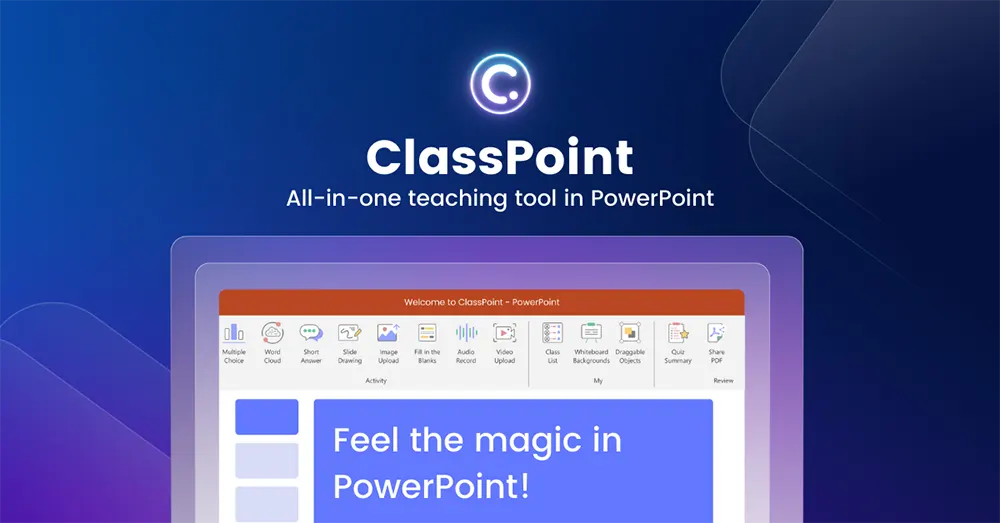
The synergy between constructivism learning theory and technology creates a rich soil for educational innovation, and ClassPoint is at the forefront, providing tools that make learning an active, engaging process. By incorporating ClassPoint into the classroom, educators can seamlessly blend tech with teaching, offering experiences that are perfectly aligned with the tenets of constructivism.
Sparking Curiosity with a Pop Quiz
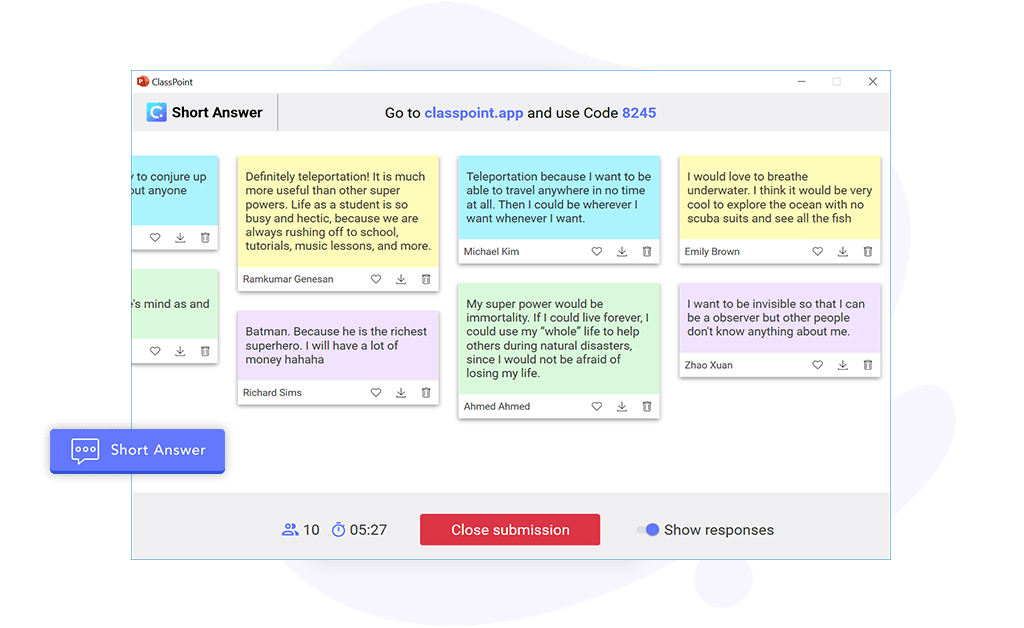
Utilize ClassPoint to create a pop quiz that serves as a conversation starter for the day’s lesson. As students submit their answers, they’re not only engaging with the content but are also actively constructing their knowledge based on their responses and the subsequent class discussion.
How to facilitate this with ClassPoint:
- Add a quiz button in your PowerPoint slide using ClassPoint’s interactive quizzes and project it onto the screen as students walk in.
- Launch the quiz by clicking on the quiz button during slideshow mode.
- Students use their devices to answer, promoting a tech-friendly, interactive start to the lesson.
- Discuss the answers as a class, encouraging students to explain their reasoning, fostering a deeper understanding through peer learning.
Explore 25 ways to use ClassPoint questions to spice up your pop quizzes!
Harnessing Immediate Insights with Formative Assessments
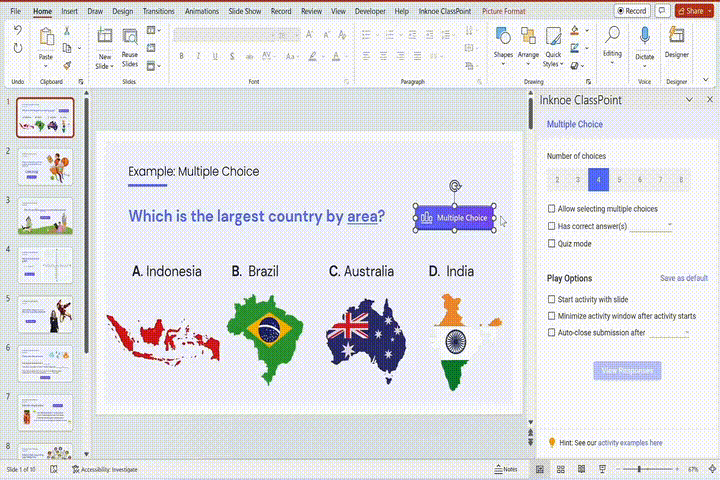
In a constructivist classroom, feedback is immediate and formative. Use ClassPoint’s real-time response system during a lesson to gauge comprehension and adjust your teaching on the fly.
How to facilitate this with ClassPoint:
- Add a multiple choice quiz button in your PowerPoint slide.
- Enable Quiz Mode at the settings panel.
- Launch the quiz by clicking on the quiz button in slideshow mode.
- Students answer via their own devices. The quiz is automatically graded and responses are displayed instantly.
- Address any widespread misconceptions immediately, ensuring that learning is constantly tailored to student needs.
Pro tip: flip the script. While letting your students join in on the fun can be rewarding, there's also merit to providing them with immediate feedback. Here's how you can give your class effective feedback.
Collaborative Problem Solving
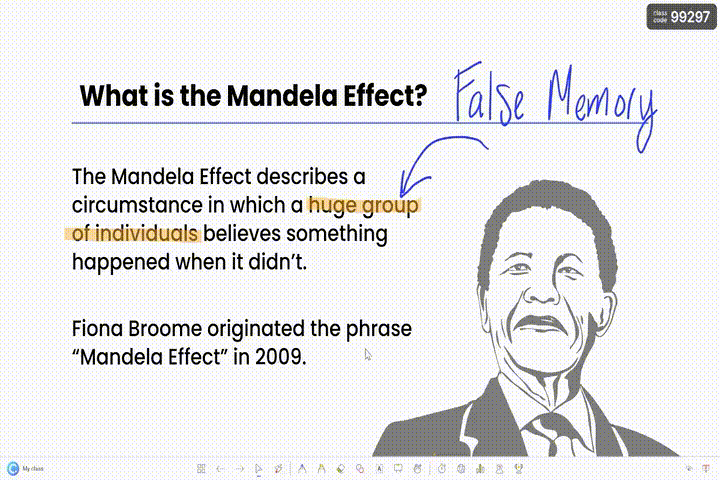
Encourage students to solve a problem together by using ClassPoint’s whiteboard backgrounds feature. This shared digital space allows for collective note-taking, drawing, and brainstorming, which are central to constructivist practices.
How to facilitate this with ClassPoint:
- Present a problem or case study via your PowerPoint slides.
- Invite students to contribute to the whiteboard, adding their ideas and solutions through Smartboard or slide drawing.
- Facilitate a group discussion that lets students reflect on the collaborative process and the solutions generated.
Enhancing Critical Thinking with ClassPoint AI and Bloom’s Taxonomy
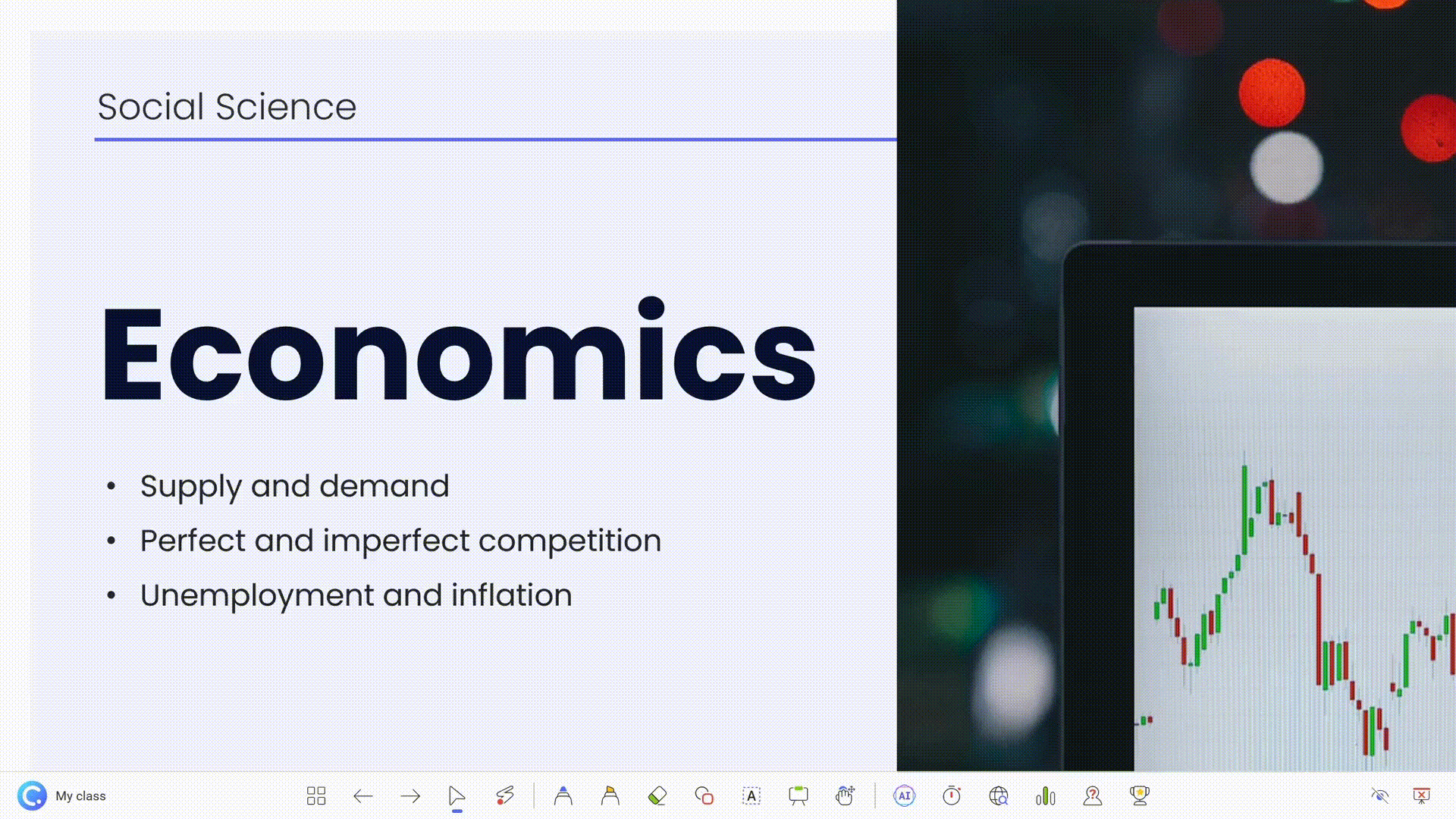
ClassPoint AI can be leveraged to frame questions based on Bloom’s Taxonomy, encouraging critical thinking and inquiry-based learning. This approach facilitates a deeper understanding of subjects by pushing students to analyze, evaluate, and create, rather than just remember and understand.
How to Facilitate This with ClassPoint:
- Craft questions using ClassPoint AI that are tailored to various Bloom’s Taxonomy levels, ensuring a range of cognitive challenges.
- Integrate these questions into your PowerPoint presentation to stimulate higher-order thinking.
- Engage students in discussions about their answers, fostering critical thinking and deeper comprehension.
Flipping the Classroom with Quizzes and SharePDF
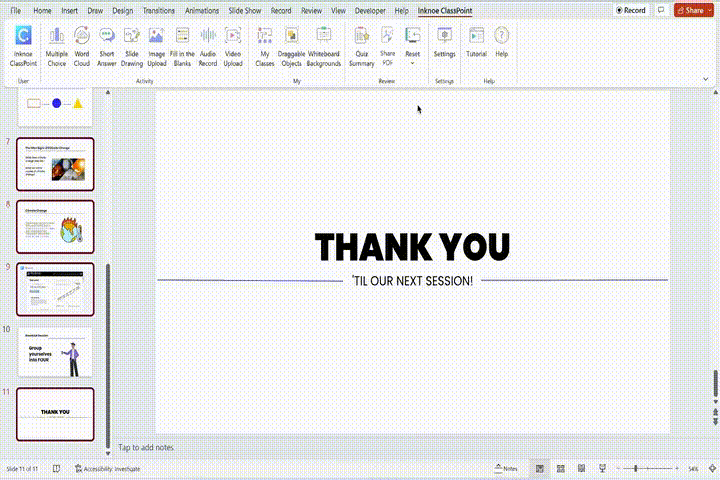
ClassPoint’s quiz and SharePDF features are perfect for implementing a flipped classroom model. Teachers can create quizzes for students to complete as homework, and SharePDF allows for the easy distribution of lecture materials for pre-class review.
How to Facilitate This with ClassPoint:
- Prepare a quiz using ClassPoint for students to complete before class, covering key concepts of the upcoming lesson.
- Convert your PowerPoint presentation to a PDF with SharePDF and share it with students, providing them with material to study in advance.
- Use class time for interactive discussions and activities based on the pre-taught material and quiz results.
Pro Tip: Share your presentation slides as QR codes using ClassPoint's SharePDF feature and place them across different stations across the classroom before the start of the class to encourage students to have a quick discussion on the various topics and concepts before the class.
Using Name Picker and Timer for Group Activities and Projects
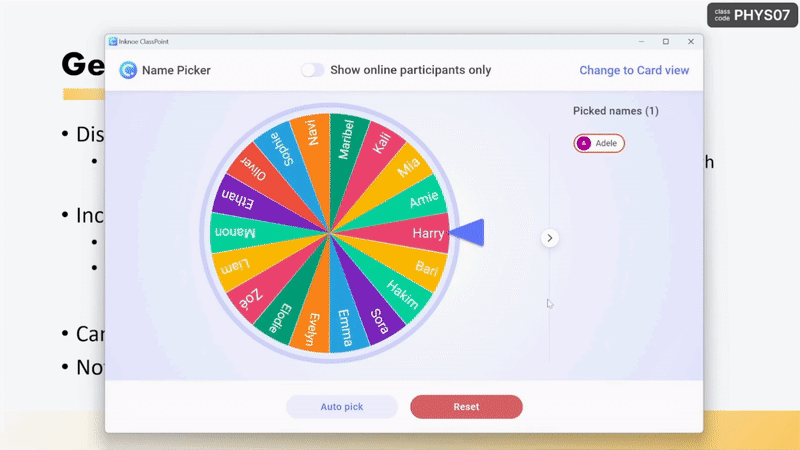
The Name Picker and Timer in ClassPoint is excellent for managing group activities or projects. They help keep students engaged and adds a sense of urgency and excitement to the tasks.
How to Facilitate This with ClassPoint:
- Use the name picker to divide the class into smaller groups.
- Set a timer for group activities or project phases using ClassPoint.
- Display the countdown during the activity to keep students aware of the remaining time.
- Use the timer to facilitate quick transitions between different phases of the project or activity.
Progressive Difficulty Quizzes for Scaffolding
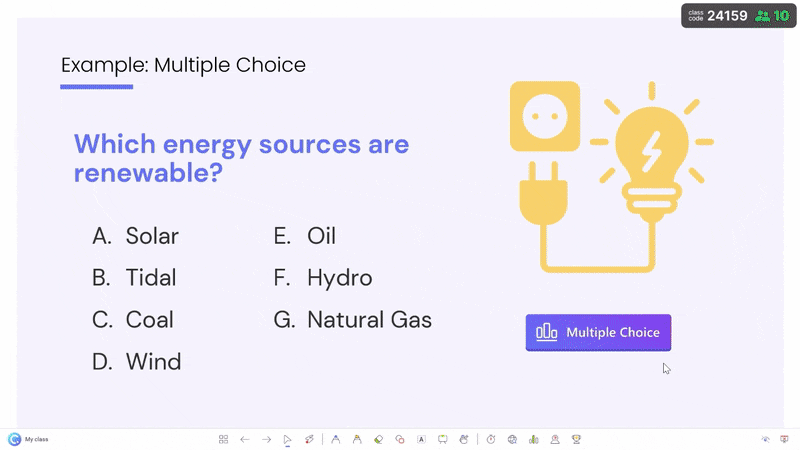
ClassPoint’s quiz feature can be used to create quizzes with progressively difficult questions, aligning with the scaffolding teaching method. This approach gradually increases the complexity of material, supporting student learning and confidence.
How to Facilitate This with ClassPoint:
- Design a series of quizzes in ClassPoint with increasing levels of difficulty.
- Start with basic recall questions and gradually include more complex, analytical ones.
- Use these quizzes to gauge student understanding and adapt the teaching pace accordingly.
Pro Tip: Encourage different creative ways of answer submission through ClassPoint's Image Upload, Video Upload and Audio Record.
Student-Led Demonstrations or Projects
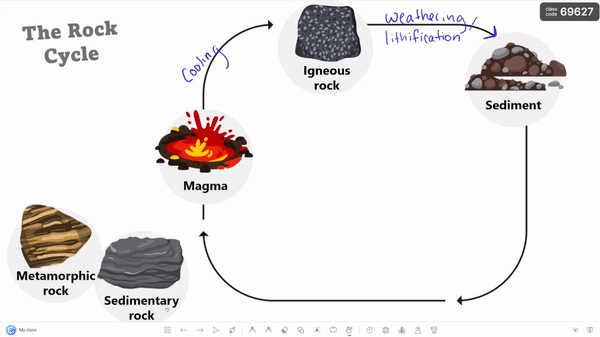
ClassPoint interactive presentation and quiz tools are not only limited to teachers. Students can use them to present their findings or ideas in an interactive and engaging manner.
How to Facilitate This with ClassPoint:
- Invite students to download ClassPoint on their laptop devices.
- Encourage the use of interactive presentation tools like annotations, shapes, text boxes and draggable objects during their presentations.
- Students can also conduct interactive quiz or quick poll to further engage with the audience.
- They can use ClassPoint’s Embedded Browser to embed additional relevant information or media content from live website into their PowerPoint slides during presentation to allow a more seamless and fun presentation experience.
Try ClassPoint for a Constructivist Classroom Makeover!
Ready to bring constructivism learning theory to life in your classroom? Experience the difference with ClassPoint—try it for free and watch your students thrive in an active, collaborative, and engaging learning environment. Start your journey with ClassPoint today!
By integrating the principles of constructivism into your teaching practice with tools like ClassPoint, you can create an educational experience that is not only more engaging for students but also more rewarding for educators.